![]()
![]()
![]()
Use LEFT and RIGHT arrow keys to navigate between flashcards;
Use UP and DOWN arrow keys to flip the card;
H to show hint;
A reads text to speech;
189 Cards in this Set
- Front
- Back
- 3rd side (hint)
|
228(a) 7 years ca1961 |
Everyone who
With intent to obtain
Any property Or Pecuniary advantage Or Service Or Valuable consideration
Dishonestly
And without claim of right
Takes Or Obtains
Any document |
|
|
|
228(b) ca1961 7 yrs |
Everyone who
With intent to obtain
Any property Or Pecuniary advantage Or Service Or Valuable consideration
Dishonestly
And without claim of right
Uses Or Attempts to use
Any document |
|
|
|
Obtain s217 ca1961 |
Obtain in relation to any person, means to obtain or retain for himself or herself or for any other person |
|
|
|
Property s2 ca1961 |
Property includes real or personal property, and any estate or interest in any real or personal property, money, electricity,and any debt, any any thing in action, and any other right or interest |
|
|
|
Service is not defined in the crimes act 1961 |
R v cara- service is limited to financial or economic value, and excludes privileges or benefits |
|
|
|
What must be proved in the ingredients of takes or obtains document? |
The defendant must intend to obtain And He or she must intent to obtain by deception |
|
|
|
Hayes v r- pecuniary advantage |
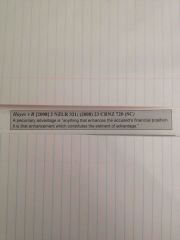
A pecuniary advantage is "anything that enhances the accuseds financial position. It is the enhancement which constitutes the element of advantage. |
|
|
|
Examples of valuable consoderation |
-Monetary payment in return for goods or services
-Goods given in return for services provided
-issuing a false invoice to receive payment for goods never supplied
|
|
|
|
Dishonestly s217 ca1961 |
Dishonestly, in relation to an act or omission, means done or omitted without a belief that there was express or implied consent to or authority for, the act or omission from a person entitled to give such consent or authority |
|
|
|
It just be proved the defendant had a dishonest mind unless the defendant can raise beyond reasonable doubt a relevant but mistaken belief: That belief may be either: |
-the act or omission was, expressly or inpliedly, consented to by a person entitled to give consent Or -that the act or omission was authorised by a person entitled to authorise it |
|
|
|
R v Hayes- dishonest belief |

The question is whether the belief is actually held, not whether that belief is reasonable. However, reasonableness may be relevant as evidence on the issue of whether the belief was actually held. |
|
|
|
R v Hayes- dishonest belief |
The question is whether the belief is actually held, not whether that belief is reasonable. However, reasonableness may be relevant as evidence on the issue of whether the belief was actually held. |
|
|
|
Claim of right s2 ca1961 |
Claim of right in relation to any act, means a belief at the time of the act in a proprietary or possessory right in property in relation to which the offence is alleged to have been committed, although that belief may be based on ignorance or mistake of fact or of any matter of law other than the enactment against which the offence is alleged to have been committed |
|
|
|
Takes/ taking section 219(4) ca1961 |
For tangible property, theft is committed by a taking when the offender moves the property or causes it to be moved. |
|
|
|
Takes/ taking section 219(4) ca1961 |
For tangible property, theft is committed by a taking when the offender moves the property or causes it to be moved. |
|
|
|
R v misic- document |
Essentially a document is a thing which provides evidence or information or serves as a record. |
|
|
|
Takes/ taking section 219(4) ca1961 |
For tangible property, theft is committed by a taking when the offender moves the property or causes it to be moved. |
|
|
|
R v misic- document |
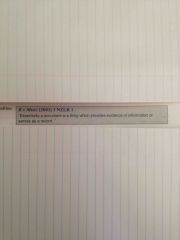
Essentially a document is a thing which provides evidence or information or serves as a record.
|
|
|
|
Document s217 ca1961 |
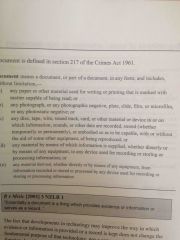
Back (Definition) |
|
|
|
What must the prosecution prove with use/attempted to use? |
That the offender used/attempted to use the dicey men with intent to obtain the property, pec adv, service or val consideration. |
|
|
|
What must the prosecution prove with use/attempted to use? |
That the offender used/attempted to use the dicey men with intent to obtain the property, pec adv, service or val consideration. |
|
|
|
Use |
Use Can include a single action, such as handing over of a document to its intended recipient, or the continuing use of a document. |
|
|
|
R v Hayes-document |
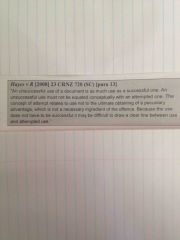
Back (Definition) |
|
|
|
S 72 ca 1951 definition of attempts |
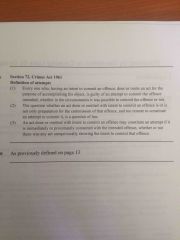
Back (Definition) |
|
|
|
S 240 ca1961 |
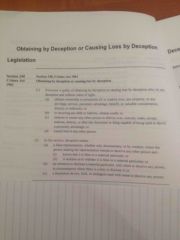
Back (Definition) |
|
|
|
Definition of Deception 240(2) ca1961
(a)(b)(c) |
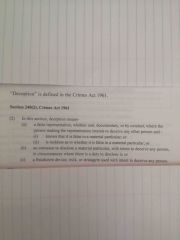
Back (Definition) |
|
|
|
What is required to be proved? |
-that there was an intent to deceive
-that there was a representation by the defendant
-that the representation was false And that the defendant either: Knew it to be false OR Was reckless whether it was false in material particular. |
|
|
|
Section 240(1) (a) ca1961 Obtaining by deception or causing loss by deception |
1.Everyone who 2. By any deception 3.and without claim of right 4. Obtains 5. Ownership of Or Possession of Or Control over
6.any property Any privilege Any pecuniary advantage Any Service Any Benefit Any valuable consideration
6. Directly Or indirectly |
|
|
|
S 240(1)(b) ca 1961 |
1.Everyone who 2. By any deception 3.and without claim of right 4. In incurring any debt Or liability 5. Obtains credit |
|
|
|
S 240(1)(b) ca 1961 |
1.Everyone who 2. By any deception 3.and without claim of right 4. In incurring any debt Or liability 5. Obtains credit |
|
|
|
S 240(1)(c) ca 1961 Obtaining by deception Or causing loss by deception |
1.Everyone who 2. By any deception 3.and without claim of right 4. Induces Or Causes any other person to
5. DEMADEA Deliver over OR Execute Make Accept Destroy Endorse Alter
6.any document Or thing capable of being used to derive a pecuniary advantage |
|
|
|
S 240(1)(b) ca 1961 Obtaining by deception or causing loss by deception |
1.Everyone who 2. By any deception 3.and without claim of right 4. In incurring any debt Or liability 5. Obtains credit |
|
|
|
S 240(1)(c) ca 1961 Obtaining by deception Or causing loss by deception |
1.Everyone who 2. By any deception 3.and without claim of right 4. Induces Or Causes any other person to
5. DEMADEA Deliver over OR Execute Make Accept Destroy Endorse Alter
6.any document Or thing capable of being used to derive a pecuniary advantage |
|
|
|
S 240(1)(d) ca 1961 Causing loss by deception |
1.Everyone who 2. By any deception 3.and without claim of right 4. Causes loss to any other person |
|
|
|
Intention to deceive R v Morley |
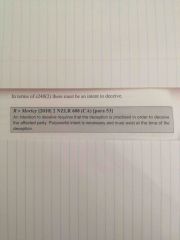
|
|
|
|
R v mohan R v waaka |
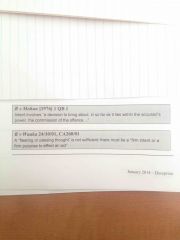
Back (Definition) |
|
|
|
Intent- Simester and brook banks principles of criminal law |
A person does something intentionally if they mean to do it, they desire a specific result and act with the aim or purpose of achieving it. |
|
|
|
Examples of intent to deceive |
Orally- verbally claiming to own goods that are subject to h/p
By conduct- representing oneself to be a collector for charity
Document- presenting a false certificate of qualification, or completing a valueless cheque on an account where there are no funds |
|
|
|
R v Harney Recklessness
|
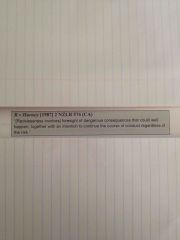
|
|
|
|
Device Trick Stratagem |
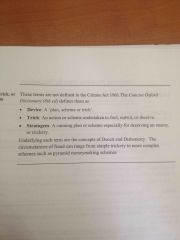
Back (Definition) |
|
|
|
Knowledge can be established by: |
An admission
Implication from the circumstances surrounding the event
Propensity evidence |
|
|
|
Definition of material particular |
Not defined in crimes act, can be given its usual meaning of an important, essential or relevant detail or item |
|
|
|
Subjective/ objective test |
Subjective- internal reasons a person acts as he or she does
Objective test- is the test of a reasonable person |
|
|
|
Definition of omission |
Not defined in crimes act. Omission is not acting. A conscious decision not to do something or not giving thought to the matter at all |
|
|
|
Device definition |
A plan, scheme or trick |
|
|
|
Device definition |
A plan, scheme or trick |
|
|
|
Trick |
An action or scheme undertaken to fool, outwit or deceive |
|
|
|
Device definition |
A plan, scheme or trick |
|
|
|
Trick |
An action or scheme undertaken to fool, outwit or deceive |
|
|
|
Stratagem |
A cunning plan or scheme especially for deceiving an enemy, or trickery |
|
|
|
Privilege or benefit examples: |
-Using another persons gym membership card
-access to medical services
-the withdrawal of an assault Charge
-a reduction in sentence for an offence |
|
|
|
When are goods obtained by someone? War |
Goods are obtained if the goods come under their control, even though they may not have physical possession of them.
Eg. Cheque sent in mail-obtaining is complete at the time of posting |
|
|
|
Explain the difference between theft and obtaining by deception. |
In Theft the property is obtained without the owners permission and title is not passed on |
|
|
|
Warner v met pol com |
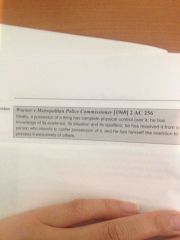
|
|
|
|
Constructive possession |
Arises when Something is not in a persons physical custody but they have ready access to it or can exercise control over it |
|
|
|
Cobtrol |
Means to exercise authoritative or dominating influence or command over it
Does not need to possess something in order to control it |
|
|
|
Control |
Means to exercise authoritative or dominating influence or command over it
Does not need to possess something in order to control it |
|
|
|
Pecuniary advantage definition and examples |
Means economy or monetary advantage
Eg. -cash from stolen goods -cash or clothing obtained by a credit or EFTPOS card -a discount- using student ID card -avoiding or deferring a payment of debt |
|
|
|
Debt |
Means owing money from one person to another |
|
|
|
Debt |
Means owing money from one person to another
The debt must be legally enforceable |
|
|
|
Debt |
Means owing money from one person to another
The debt must be legally enforceable |
|
|
|
Liability |
Means a legally enforceable financial obligation to pay, such as the cost of a meal |
|
|
|
Credit |
Refers to the obligation on the debtor to pay or repay, and the time given for them to do so by the creditor |
|
|
|
What must be proved in 240(1)(b)? |
-The identity of the suspect -that they by deception and without claim of right -in incurring any debt or liability -obtained credit |
|
|
|
Fisher V Raven |
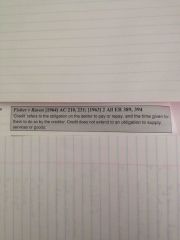
|
|
|
|
Timing of intention to deceive
R v McKay |
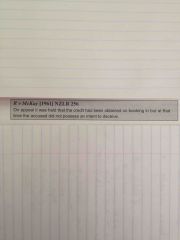
|
|
|
|
Examples of where credit may be obtained: |
-obtaining money on loan -extending existing overdraft facilities -renting or leasing a dwelling |
|
|
|
Is gaining credit unlawful? |
Not unless it is accompanied by an intent to deceive |
|
|
|
Intent to deceive is not disclosed when there is delay or non payment of a debt. Give examples: |
To incur a debt then be unable to pay through unforeseen circumstances, loss of money or oversight is not deceit
General dissatisfaction with a meal/service |
|
|
|
Induce |
Means to persuade, bring about or give rise to
Concise Oxford dictionary 8th edition |
|
|
|
Proof of inducement.
The victim is usually questioned to elicit answers proving: |
-that the false representation was believed -that it was the consequence of that belief that the victim parted with his or her money |
|
|
|
R v laverty
Inducement |

|
|
|
|
Causes |
The accused must cause the loss |
|
|
|
Demadea definitions |
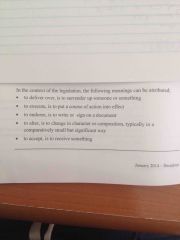
Back (Definition) |
|
|
|
Thing |
Thing is a broad and encompassing concept.
A thing must be tangible.
The thing must be capable of being used to derive a pecuniary advantage |
|
|
|
Loss |
Loss is not defined by statute but in most cases will involve a financial detriment to the victim.
The loss caused by deception must be in the nature of a direct loss |
|
|
|
Loss case law R v Morley? |
Loss is assessed by the extent to which the complainants position prior to the offence has been diminished or impaired. |
|
|
|
Person S2 ca 1961
Incorporates not only real people but also companies and other organisations. |
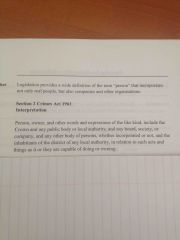
|
|
|
|
What is required to be proved in S 240(1) ca1961 |
The prosecution must prove:
-Must prove that the loss was caused by a deception
-must prove that it was reasonably forseable some more than trivial loss would occur BUT -need not prove the loss was intentionally caused
|
|
|
|
section 241 penalty
|
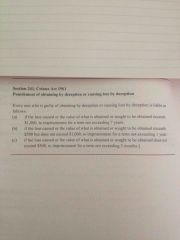
Back (Definition) |
|
|
|
Privilege or benefit definition |
Special right or advantage |
|
|
|
Case law all |
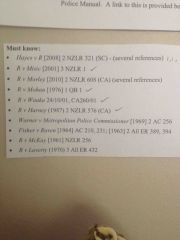
|
|
|
|
Section 40 Evidebce Act 2006
Propensity Evidebce |
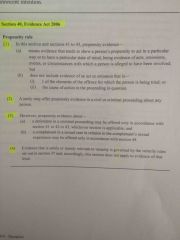
|
|
|
|
Section 43 Evidence Act 2006
Prosecution may offer propensity evidence |
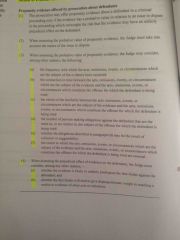
Back (Definition) |
|
|
|
R v cara
Service |
Service is limited to financial or economic value, and excludes privileges or benefits |
|
|
|
Deliver over |
Surrender up something/someone |
|
|
|
Deliver over |
Surrender up something/someone |
|
|
|
Execute |
Put s course of action into effect |
|
|
|
Deliver over |
Surrender up something/someone |
|
|
|
Execute |
Put s course of action into effect |
|
|
|
Accept |
Receive something |
|
|
|
Deliver over |
Surrender up something/someone |
|
|
|
Execute |
Put s course of action into effect |
|
|
|
Accept |
Receive something |
|
|
|
Endorse |
Write/sign a document |
|
|
|
Deliver over |
Surrender up something/someone |
|
|
|
Execute |
Put s course of action into effect |
|
|
|
Accept |
Receive something |
|
|
|
Endorse |
Write/sign a document |
|
|
|
Alter |
Change in character or composition |
|
|
|
Deliver over |
Surrender up something/someone |
|
|
|
Execute |
Put s course of action into effect |
|
|
|
Accept |
Receive something |
|
|
|
Endorse |
Write/sign a document |
|
|
|
Alter |
Change in character or composition |
|
|
|
Thing |
Broad and encompassing concept. Must be tangible, capable of being used to derive a pecuniary advantage |
|
|
|
Title |
A legal right to property
A thief never gets title |
|
|
|
Voidable title |
If obtained by deception the title can be avoided(vacated) by the seller |
|
|
|
If an innocent purchaser buys goods obtained by deception before the title is voided, are they are entitled to the title? |
Yes |
|
|
|
If an innocent purchaser buys goods obtained by deception before the title is voided, are they are entitled to the title? |
Yes |
|
|
|
What is necessary to avoid (vacate) title? |
Report it to the Police
Take all steps to communicate- mail, newspaper, phone. |
|
|
|
Cause |
The defendant must cause the loss.
The loss must be a direct loss |
|
|
|
When is propensity evidence admissible? |
In cases of deception where there is a sufficiently strong connection between the offences |
|
|
|
Proof of inducement |
Should come from the victim of deception proving: False representation was believed It was the consequence of that belief that the victim parted with their money |
|
|
|
Valuable consideration examples |
Monetary payment in return for goods or services
Goods given in return for services provided
Issuing a false invoice to receive payment for goods never supplies |
|
|
|
What is propensity Evidence? |
It is evidence which shows a person has a propensity to act in a certain way/ or to have a particular state of mind.
Can be used to disprove a defence of mistake or innocent intention |
|
|
|
When is propensity admissible? |
In cases of deception-where there is a sufficiently strong connection between the offences, Whether on previous or later occasions to the offence charged. |
|
|
|
Title |
A right to claim to the ownership of property
Concise Oxford dictionary 8th ed |
|
|
|
What is necessary to avoid title? |
1. Communication with --- 2. Taking all possible steps to communicate with ---eg letter, text, phone call, email 3. Reporting to police
|
|
|
|
What is voidable title? |
Where title is obtained by deception, fraud, duress or misrepresentation |
|
|
|
Section 25 of the sales of goods act 1908 |
If A has not voided title before their property has been sold on from b to c, c gains good title and possession. |
|
|
|
What are the two core elements that are required to be proved under S220? |
(a) that he or she received the property, on terms or circumstances,to the defendants knowledge, affect what the accused may do with the property, or its proceeds, or require the defendant to act in accordance with the requirements of another person AND (b) that the defendant departed from the relevant obligation |
|
|
|
Two different mental elements of 220 |
1st- defendant must be aware of the terms that required him to account for the property
2nd- the defendant must have intentionally departed from his/her obligation
Intentionally failing to perform ones obligation is sufficient for liablilty |
|
|
|
What must exist in relation to debt and liability? |
Debt and liability must be legally enforceable |
|
|
|
Propensity evidence offered by prosecution Section 43 (1) |
The prosecution may offer evidence against the defendant in a criminal proceeding, only if that evidence has a probative value in relation to an issue in dispute in the proceeding which outweighs the risk that the evidence may have an unfairly prejudicial effect on the defendant |
|
|
|
Section 43(2) propensity evidence offered by the prosecution |
(2) when assessing the probative value of propensity evidence, the judge must take into account the nature of the issue in dispute |
|
|
|
Section 43(2) propensity evidence offered by the prosecution |
(2) when assessing the probative value of propensity evidence, the judge must take into account the nature of the issue in dispute |
|
|
|
S 43(3) propensity evidence offered by the prosecution |
(3) when assessing the probative value of propensity evidence, the judge may consider, among other matters, the following (a)- (f) (a) frequency with which the a,o,e,c which are the subject of the evidence have occurred,
(b)the connection in time between the aoec, which are the subject of the aoec which constitute the offence for which the defendant is being tried
(C) the extent of similarity between the aoec which are the subject of the aoec which constitute the offence for which the defendant is being tried
(d) the number of persons making allegations against the defendant that are the same as or similar to, the subject of the offence for which the defendant is being tried
(e) whether the allegations of (d) may be a result of collusion or suggestibility
(f) the extent to which the aoec which are the subject of the evidence and aoec which constitute the offence for which the defendant is being tried or unusual |
|
|
|
Theft by person in special relationship S 220 Max penalty 7yrs Section (1) |
(1) this section applies to any person who receives, has possession of, or control over any property, on terms or in circumstances that a person knows requires the person- (a) to account to any other person for the property, or the proceeds arising from the property OR (b) to deal with the property or any proceeds from the property, in accordance with the requirements of any other person |
|
|
|
What are the two core elements of proof required in S 220? |
1. That the defendant received possessed, had control over the property and were to account for it or deal with it in accordance with the requirements of the other person 2. That the defendant intentionally departed from the relevant obligation |
|
|
|
Forgery S. 256(1) 10 years |
Everyone who Makes a false document With the intention of using it to obtain Any PPPSBV |
|
|
|
Forgery S 256(2) 3 years |
Everyone who Makes a false document Knowing it to be false With the intent that it, in any way, be used or acted upon, whether in NZ or elsewhere as genuine |
|
|
|
When is forgery complete in forgery S. 256(1) |
-As soon as the document is made -with the intent of using it to obtain a PPPSBV |
|
|
|
When is forgery complete in forgery S. 256(1) |
-As soon as the document is made -with the intent of using it to obtain a PPPSBV |
|
|
|
When is forgery complete in S 256(2) |
-when the document is made -with the knowledge and intent that it is used or acted upon in Nz or elsewhere as genuine |
|
|
|
Forgery- Examples of material alteration to a genuine document: |
-additions -insertions -deletions -obliterations -erasures -removal of material otherwise |
ROADIE |
|
|
For a false document to be forged it must meet the definitions of: |
False and document
Essentially a false document must lie about itself |
|
|
|
Prosecution to prove in Forgery |
-Defendant know document was false -Intended either
-to use the false document to obtain OR -that the false document be used or acted upon as genuine |
|
|
|
Examples of forgery |
-writing an exam paper in the name of another person who is required to sit the exam
-forging letters of recommendation in a C/V in order to get a position
-false completing a statement of service on a witness summons |
|
|
|
Using forged documents S 257(1)(a) 10 years |
Everyone who Knowing a document to be forged Uses the document to obtain Any PPPSBV |
|
|
|
Using forged documents S 257(1)(a) 10 years |
Everyone who Knowing a document to be forged Uses the document to obtain Any PPPSBV |
|
|
|
Using a forged document S 257(1)(b) 10 years |
Everyone who Knowing a document to be forged Uses or deals with or acts upon The document As if it were genuine |
|
|
|
Using forged documents S 257(1)(a) 10 years |
Everyone who Knowing a document to be forged Uses the document to obtain Any PPPSBV |
|
|
|
Using a forged document S 257(1)(b) 10 years |
Everyone who Knowing a document to be forged Uses or deals with or acts upon The document As if it were genuine |
|
|
|
Using a forged document S 257(1)(c) 10 years |
Everyone who Knowing a document to be forged Causes any other person to use or deal with or act upon it as if it were genuine |
|
|
|
What must you prove for using a forged document? |
You must prove that:
1. The document was false 2. The user knew that the document had been 'made' with the knowledge and intent required under S 256 CA 1961 |
|
|
|
Section 258(1)(a) Altering, concealing, destroying or reproducing documents with intent to deceive 10 years |
Everyone who With intent to obtain any PPPSBV With intent to cause loss to any other person
Alters or conceals or destroys Any document Or Causes any document to be altered, concealed or destroyed |
|
|
|
Section 258(1)(a) Altering, concealing, destroying or reproducing documents with intent to deceive 10 years |
Everyone who With intent to obtain any PPPSBV With intent to cause loss to any other person
Alters or conceals or destroys Any document Or Causes any document to be altered, concealed or destroyed |
|
|
|
Section 258(1)(b) altering, concealing, destroying or reproducing documents with intent to deceive 10 years |
Everyone who With intent to obtain any PPPSBV Or With intent to cause loss to any other person
Makes a document or causes a document to be made that is In whole or in part A reproduction of any other document |
|
|
|
Difference between forgery and acdr a document? |
With forgery an intent to deceive is only required
In acdr it intends to OBTAIN by deception |
|
|
|
S 259(1)(a) 10 years USING altered or reproduced document with intent to deceive |
(1)(a) Everyone who Knowing any document to have been made or altered in a manner and with the intent referred to in S258 With intent to obtain by deception Any PPPSBV Or to cause loss to any other person
Uses or deals with or acts upon the document |
|
|
|
S 259(1)(a) 10 years USING altered or reproduced document with intent to deceive |
(1)(a) Everyone who Knowing any document to have been made or altered in a manner and with the intent referred to in S258 With intent to obtain by deception Any PPPSBV Or to cause loss to any other person
Uses or deals with or acts upon the document |
|
|
|
USING altered or reproduced document with intent to deceive S 259(1)(b) |
(1)(b) Everyone who Knowing any document to have been made or altered in a manner and with the intent referred to in S258 With intent to obtain by deception Any PPPSBV Or to cause loss to any other person
Causes any person to use or deal with or act upon The document |
|
|
|
The three mental elements of S.259 using altered or reproduced document with intent to deceive |
Firstly- the defendant must know the document had been altered with intent to deceive
Secondly- the defendant must have intended by the employment of the document to obtain by deception or cause loss to any other person
Thirdly- there must be an intention to Aquire or retain the property or to cause loss by deception |
|
|
|
A false document must: |
Lie about itself or intend to convey a lie |
|
|
|
When is an aleration a material alteration? |
If it increases the value or negotiability of a document or instrument |
|
|
|
When is forgery complete? |
When the document is made with the intent (1) Or with the knowledge and intent (2)
Forgery is complete even though the false document may be incomplete |
|
|
|
Access- in relation to computer system |
Access in relation to any computer system, means instruct, communicate with, store data in, receive data from, or otherwise make use of any of the resources of the computer system |
|
|
|
Access- in relation to computer system |
Access in relation to any computer system, means instruct, communicate with, store data in, receive data from, or otherwise make use of any of the resources of the computer system |
|
|
|
Authorisation |
Authorisation includes an authorisation conferred on a person by or under an enactment or a rule of law, or by an order of a court or judicial process |
|
|
|
Access- in relation to computer system |
Access in relation to any computer system, means instruct, communicate with, store data in, receive data from, or otherwise make use of any of the resources of the computer system |
|
|
|
Authorisation |
Authorisation includes an authorisation conferred on a person by or under an enactment or a rule of law, or by an order of a court or judicial process |
|
|
|
Computer system |
(a) means - (i) a computer or (ii) 2 or more interconnected computers or (iii) any communication links between computers or to remote terminals or another device or (iv) 2 or more interconnected computers combined with any communication links between computers or to remote terminals or any other device AND (b) includes any part of the items described in para (a) and all related input, output, processing, storage, software, or communication facilities and stored data |
|
|
|
Bank note |
Means any negotiable instrument used or intended for use as currency |
|
|
|
Benefit |
Non monetary advantage |
|
|
|
Representation |
A thing that represents another. A statement made by way of allegation or to convey opinion |
|
|
|
Valuable consideration |
A compensation, or a fee or payment
Anything capable of being valuable consideration whether monetary kind or other kind, in short money or money's worth |
|
|
|
What must you prove for S. 249(1) |
Directly or indirectly Accessed any computer Dishonestly or by deception And without claim of right Obtained ownership of, possession of, or control over Any PPPSBV Or caused loss to another person |
|
|
|
Investigating cheque and credit card fraud Step 1 |
1. Interview the informant and: -Find out the identity used by the offender -obtain descriptions of the offender, property obtained and vehicle used |
|
|
|
Investigating cheque and credit card fraud Step 2 |
Contact the accounts manager at the bank where the account is domiciled and find out:
Account holders full details- name, occ, private/business addresses/telephone numbers
DATE account was opened
Account HISTORY and how it has been operated
DATE the cheque book or credit card was reported missing
HOW and by whom a loss was reported
SERIAL numbers of any missing cheques
DETAILS of any cheques dishonoured and returned
Whether account holder is SUSPECTED of issuing valueless cheques
OTHER banks to which cheques have been returned and if possible, details of the ppl and firms defrauded
|
Adhdhsdso |
|
|
Types of offences related to credit card/ cheque fraud |
Stolen cheques or cards
Counterfeit cards
Fraudulent cheque accounts or cards
Dishonoured cheques |
|
|
|
Types of offences related to credit card/ cheque fraud |
Stolen cheques or cards
Counterfeit cards
Fraudulent cheque accounts or cards
Dishonoured cheques |
|
|
|
Step 1 of credit card/ cheque fraud investigations |
1. Interview informant find out:
Identity used by offender Descriptions of offender Property obtained Vehicle used |
|
|
|
Types of offences related to credit card/ cheque fraud |
Stolen cheques or cards
Counterfeit cards
Fraudulent cheque accounts or cards
Dishonoured cheques |
|
|
|
Step 1 of credit card/ cheque fraud investigations |
1. Interview informant find out:
Identity used by offender Descriptions of offender Property obtained Vehicle used |
|
|
|
Step 2 - in all cases regarding credit/ cheque fraud |
ADHDHDSSO
Account holder full details Date account opened History of account- how operated Date cheque/card reported missing How/by whom loss reported Details of any cheques dishonoured/returned Serial numbers of missing cheques Suspected account holder issuing valueless cheques Other banks to which cheques have bn returned and dets of ppl/firm defrauded |
|
|
|
Types of offences related to credit card/ cheque fraud |
Stolen cheques or cards
Counterfeit cards
Fraudulent cheque accounts or cards
Dishonoured cheques |
|
|
|
Step 1 of credit card/ cheque fraud investigations |
1. Interview informant find out:
Identity used by offender Descriptions of offender Property obtained Vehicle used |
|
|
|
Step 2 - in all cases regarding credit/ cheque fraud |
ADHDHDSSO
Account holder full details Date account opened History of account- how operated Date cheque/card reported missing How/by whom loss reported Details of any cheques dishonoured/returned Serial numbers of missing cheques Suspected account holder issuing valueless cheques Other banks to which cheques have bn returned and dets of ppl/firm defrauded |
|
|
|
Step 3- fictitious accounts opened |
Account number and date opened Nature of amount of 1st deposit Other deposits made-any Opened- details used when acc Serial number of cheques supplied Suspect/associates description Employee details that opened account Employees who ID suspect- get statement Details of dishonoured cheques and ppl/firm defrauded |
ANOOSSEED |
|
|
Four categories of company fraud in detail |
Category A Large scale thefts and other dishonesty offences by employees against employers
Category B Dishonesty offences committed against financial institutions by ppl outside the institution
Category C Commercial fraud committed against the public
Category D Dishonesty offences committed by professional ppl in a position of trust |
|
|
|
Assistance available from external organisations in the investigation of company fraud |
Police must come first not last |
|
|
|
Ongoing enquiries cheque/credit card fraud |
1. Liase with investigations officer and arrange: -to be advised ASAP of further dishonoured cheques -get bank to forward those cheques to you or get complainant to
2. Documents are fragile and may need examining. Do NOT: -punch, fold or crease them -use staples, pins, cello tape -make impressions on
-place in clear bag on file
3. Inform colleagues and fraud squad collator. Enter identified property that has been obtained by dishonered cheques into NIA as items |
3 steps |
|
|
Locate offender- cheque and credit card fraud |
1. Check relevant addresses 2. Follow up obvious info- Car, phone numbers, evidence of ID 3. IF- photo, property easy to ID or appropriate - implement early warning system 4. If no suspects consider fingerprinting the cheques/vouchers |
4 steps |
|
|
5 step arrest for cheque/credit card fraud |
1. Recover evidence issue 268
2. Interview suspect- get explanation
3. Cover off/find out about: Knowledge of account Expectation of funds Overdraft details if any
4. Obtain statement and handwriting samples
5. Issue OR and complete 4qs to check suspects explanation |
|
|
|
4 step to prosecution- credit card/ cheque offending |
1. Authority to charge from supervisor
2.file appropriate charge
3. Prep file
4. Prep blanket charge if suspect pleads/ difficult to establish dates |
|
|
|
Section 249(1) 7 yrs Accessing computer system for dishonest purpose |
-Everyone who -Directly or indirectly -Accesses any computer system -And thereby -Dishonestly or by deception -And without COR -(a) obtains PPPSBV -(b) causes loss to any other person |
|
|
|
Section 249(2) 5 yrs Accessing computer system for dishonest purpose |
-everyone who -directly or indirectly -accesses any computer -with intent -dishonestly or by deception -and without COR (a) to obtain any PPPSBV (b) to cause loss to any other person |
|
|
|
Fraudulent |
Dishonest in the traditional moral sense |
|

